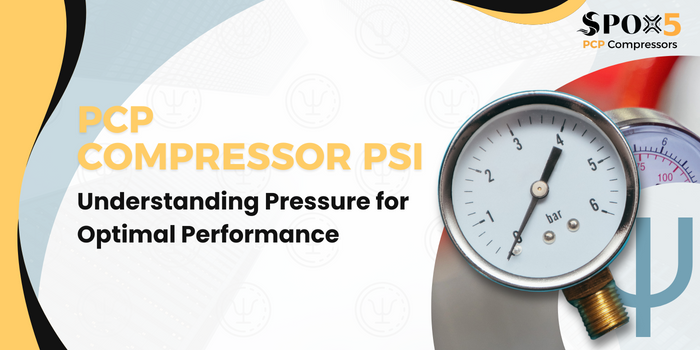The world of compressors can be a complex one, filled with technical jargon and crucial factors for efficient operation. PCP, or progressing cavity, compressors are a specific type known for their versatility in industrial applications. But within this world, understanding PCP compressor PSI (pounds per square inch) is key to ensuring optimal performance and system longevity.
This blog dives deep into the concept of PCP compressor PSI, explaining its role, how it’s measured, and the factors that influence it. We’ll also explore the importance of maintaining proper PSI levels for your specific needs.
PCP Compressors: A Unique Design
PCP compressors, unlike their piston or centrifugal counterparts, utilize a single screw design. This screw rotates within a fixed elastomeric stator, creating progressive cavities that trap and transport fluid. This positive displacement mechanism allows PCP compressors to handle viscous fluids, slurries, and even solids with ease.
The Role of PSI in PCP Compressors
PSI, or pounds per square inch, is a unit of pressure measurement. In the context of PCP compressors, it represents the force exerted by the compressed air or gas on the walls of the discharge pipe per unit area. Higher PSI signifies greater pressure output from the compressor.
PSI plays a critical role in various aspects of PCP compressor operation:
- Flow Rate: Higher PSI directly translates to a higher flow rate of the compressed air or gas. This allows the compressor to deliver a larger volume of gas per unit time, crucial for applications requiring significant air power.
- Material Handling: For applications involving viscous materials or solids, achieving a high enough PSI is necessary to overcome the material’s resistance to flow and ensure proper transportation.
- System Efficiency: Maintaining optimal PSI levels helps the compressor operate efficiently. Excessive pressure creates unnecessary strain on the system, leading to increased energy consumption and potential wear and tear.
Measuring PCP Compressor PSI
Measuring PCP compressor PSI is a straightforward process. Most compressors come equipped with a pressure gauge on the discharge line. This gauge displays the real-time pressure output in PSI.
Here’s a breakdown of the typical measurement process:
- Locate the pressure gauge on the discharge line of the PCP compressor. It’s usually a dial gauge with a PSI scale.
- Turn on the compressor and allow it to reach steady operation.
- Observe the pressure gauge reading. This value represents the current PSI output of the compressor.
In some cases, additional pressure monitoring points might be installed within the system to track pressure changes across different stages.
Factors Affecting PCP Compressor PSI
Several factors can influence the PSI output of a PCP compressor:
- Speed: The rotational speed of the screw directly affects the pressure generated. Higher speeds generally lead to higher PSI output. However, this needs to be balanced with factors like motor capacity and potential wear on the screw and stator.
- Discharge Pressure Setting: Most PCP compressors allow for adjusting the discharge pressure through a regulator valve. This allows you to fine-tune the PSI output to match the specific needs of your application.
- Fluid Viscosity: The viscosity of the material being compressed plays a role. More viscous fluids require higher PSI to overcome resistance and achieve desired flow rates.
- System Backpressure: Backpressure refers to the pressure opposing the flow of compressed air or gas downstream of the compressor. Higher backpressure can reduce the effective PSI output at the discharge line.
Maintaining Optimal PSI Levels
Maintaining optimal PSI levels is crucial for efficient and safe PCP compressor operation. Here are some key points to remember:
- Consult the Manufacturer’s Specifications: Each PCP compressor model has a recommended operating PSI range specified by the manufacturer. Operating outside this range can lead to inefficiencies, potential damage, and safety concerns.
- Match PSI to Application Needs: Ensure the compressor’s PSI output is sufficient for the intended application. Insufficient pressure can lead to inadequate flow rates or inability to handle the material effectively.
- Monitor Pressure Regularly: Regularly monitor the pressure gauge to ensure it remains within the optimal range. This helps identify any potential issues like leaks or changes in system conditions that might affect PSI.
- Adjust Discharge Pressure Setting: If necessary, adjust the discharge pressure setting using the regulator valve to achieve the desired PSI level within the manufacturer’s recommendations.
By understanding PCP compressor PSI and its significance, you can ensure your compressor operates efficiently, delivers optimal performance, and has a longer lifespan. Remember, consulting your compressor’s user manual and recommendations from the manufacturer is vital for safe and effective operation.

